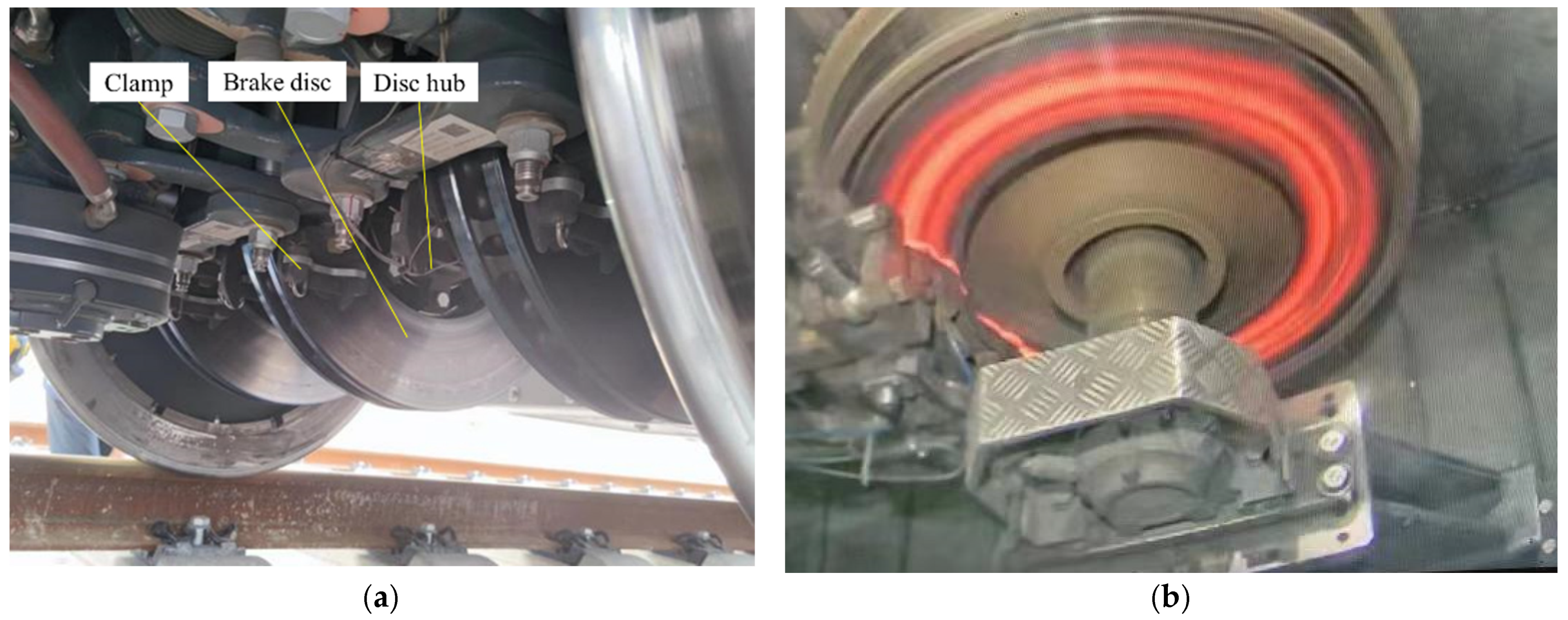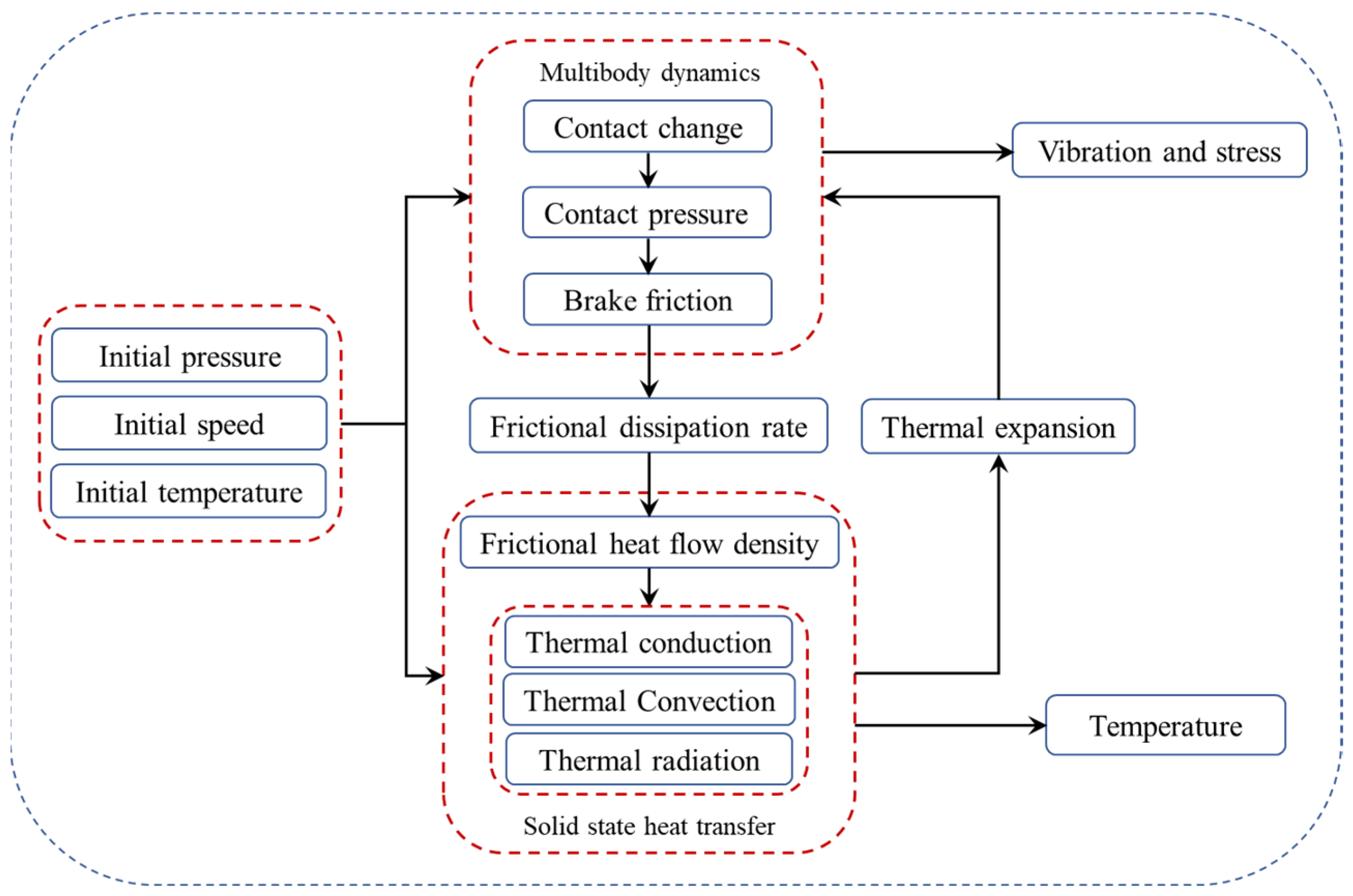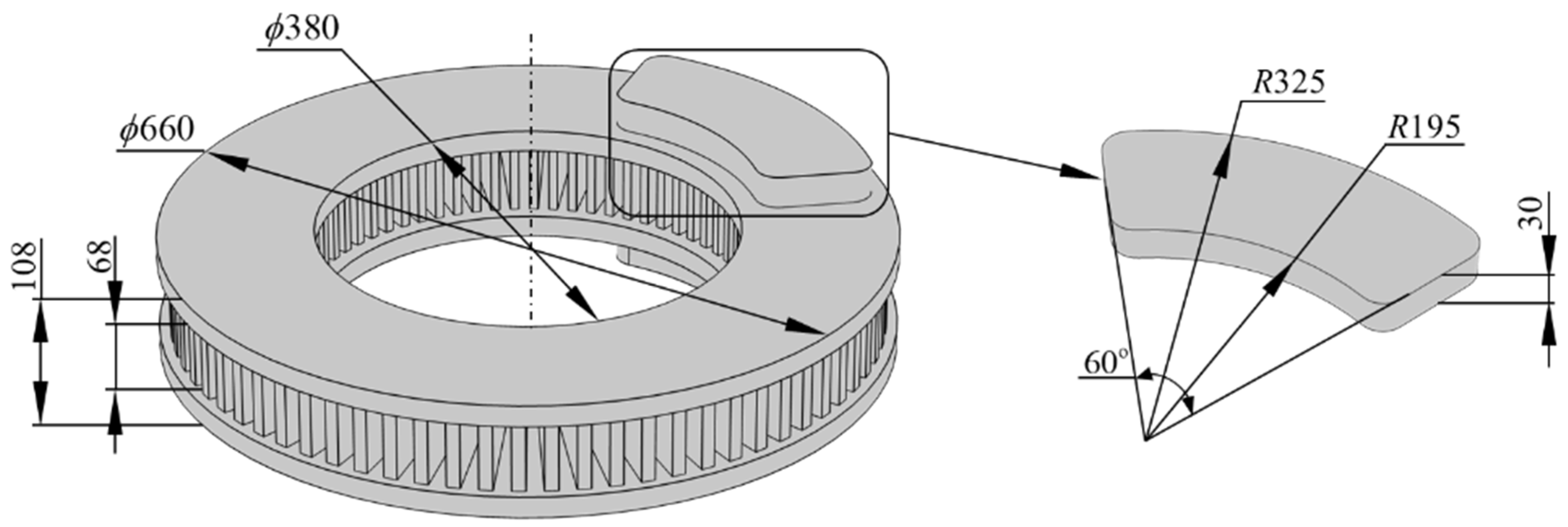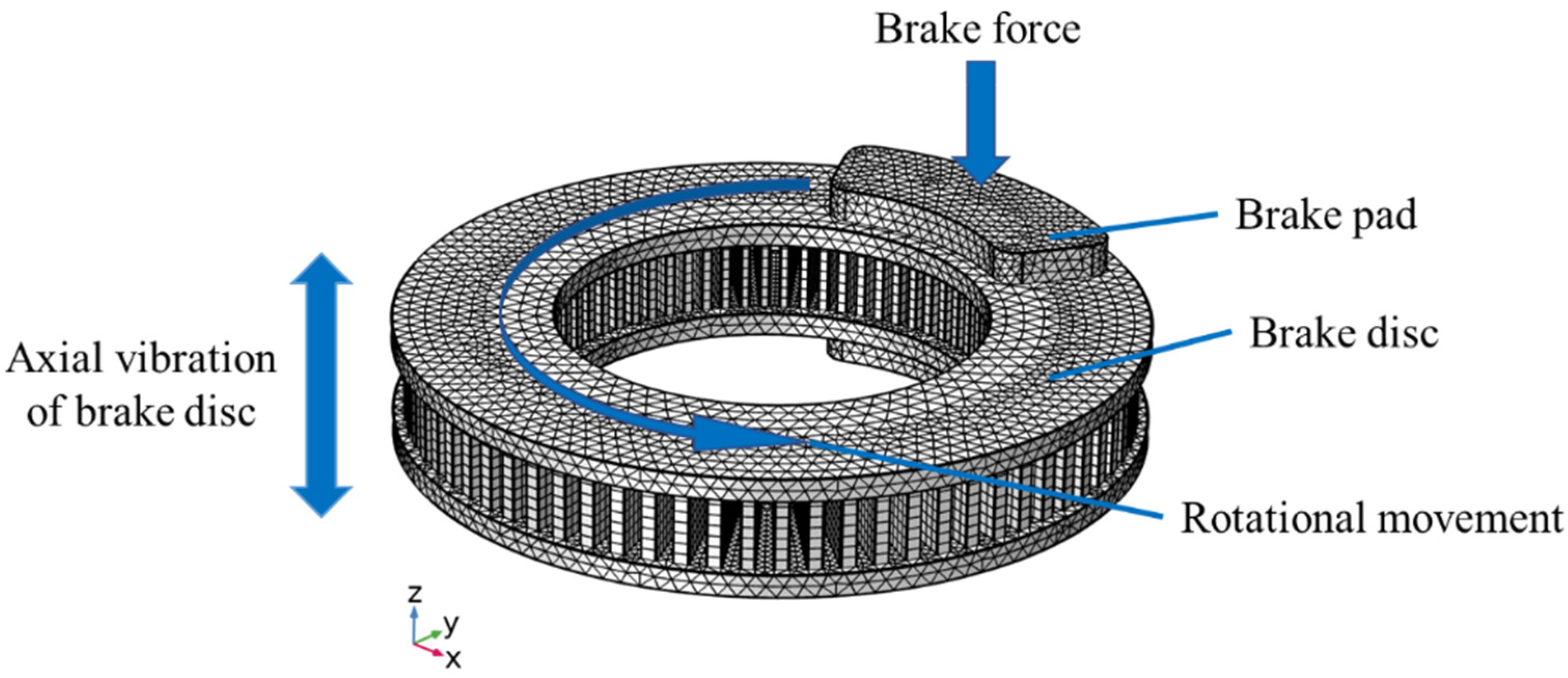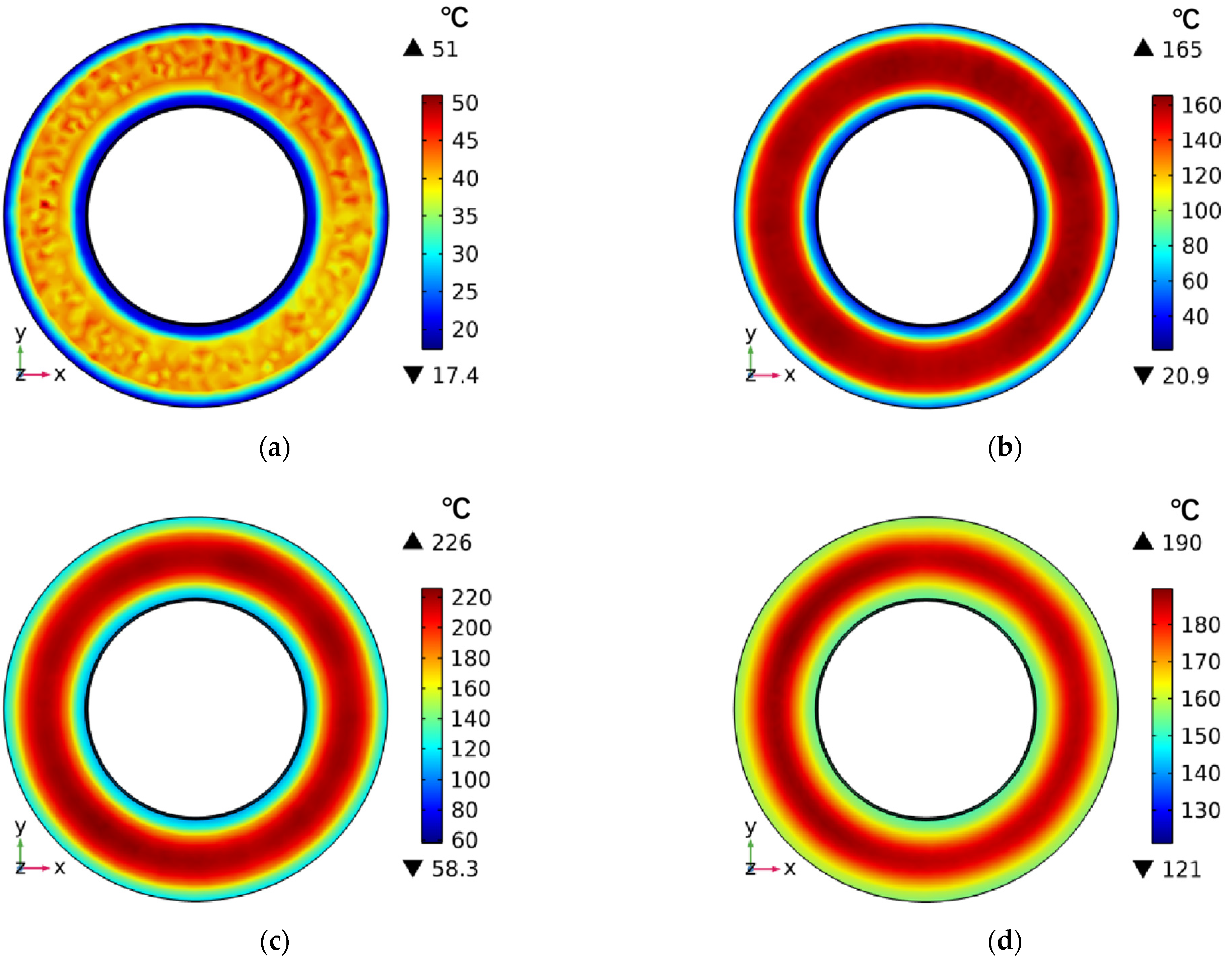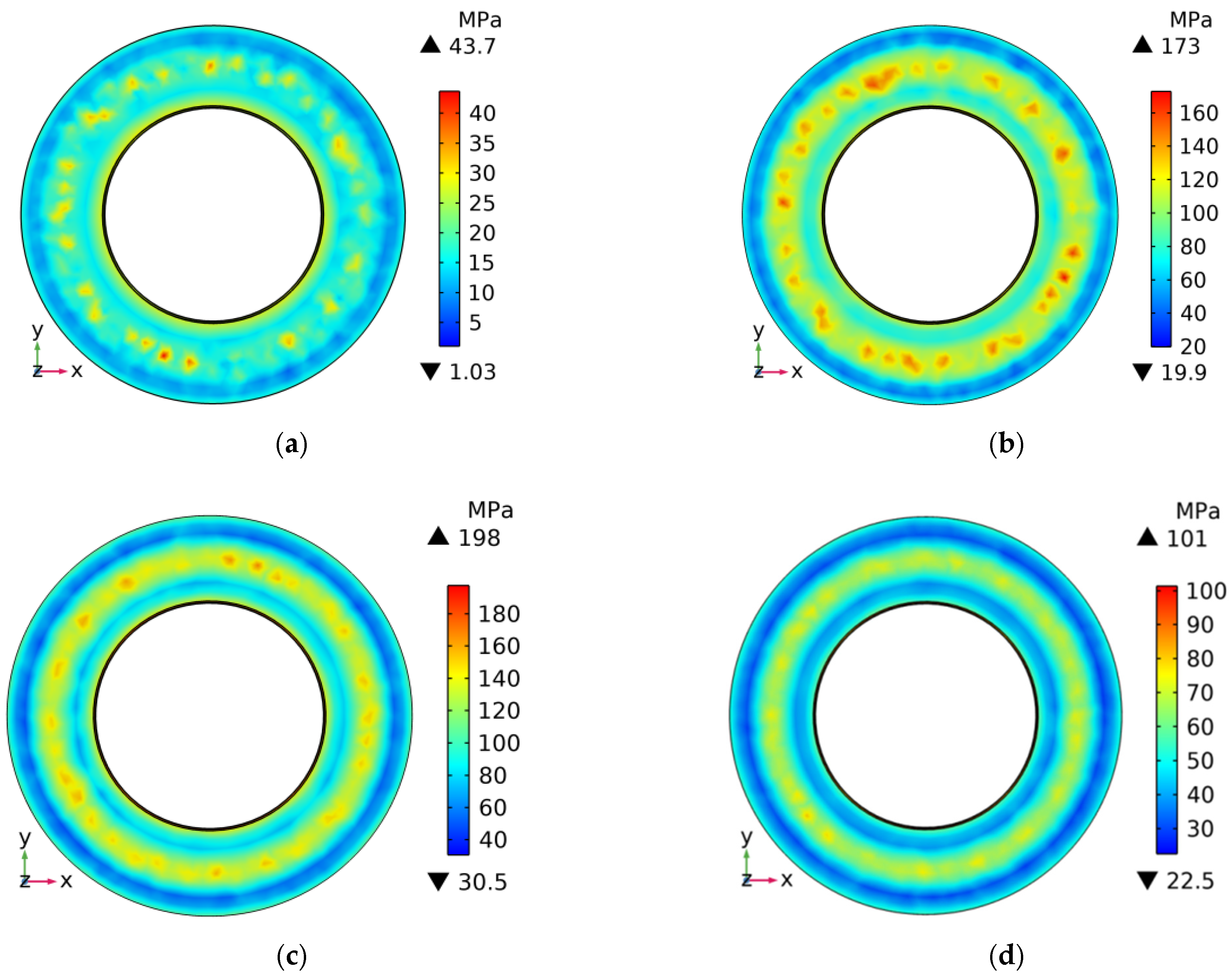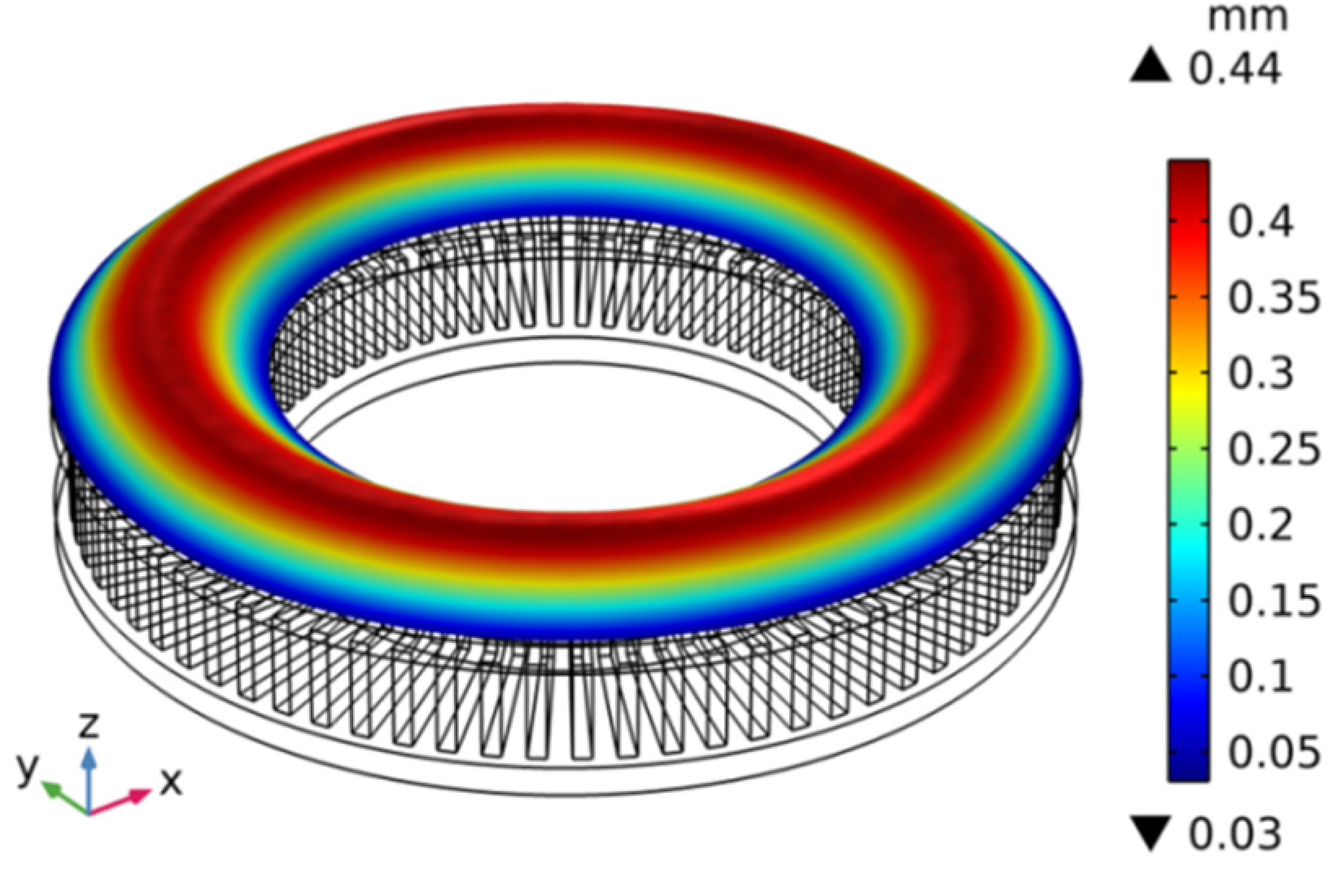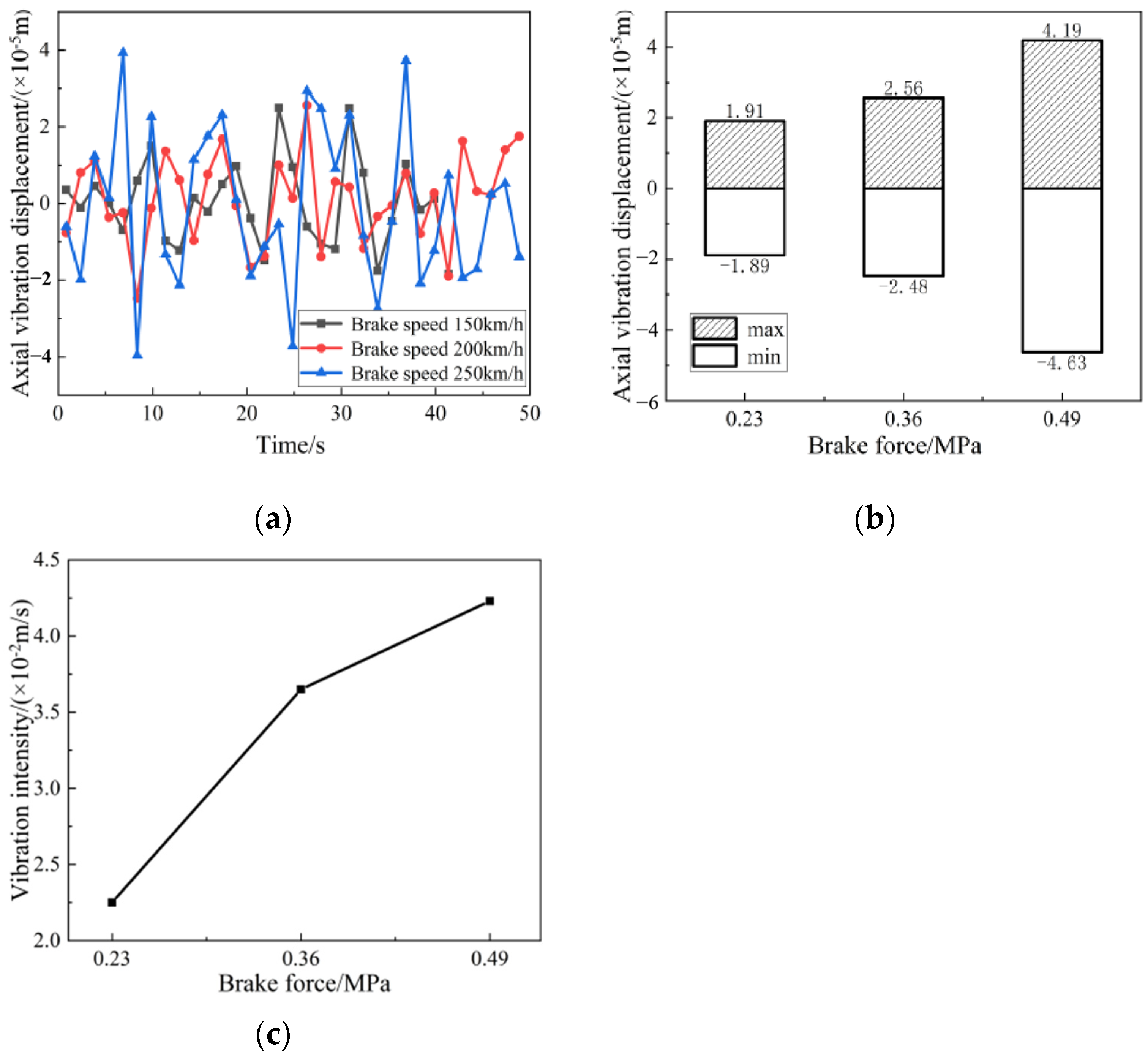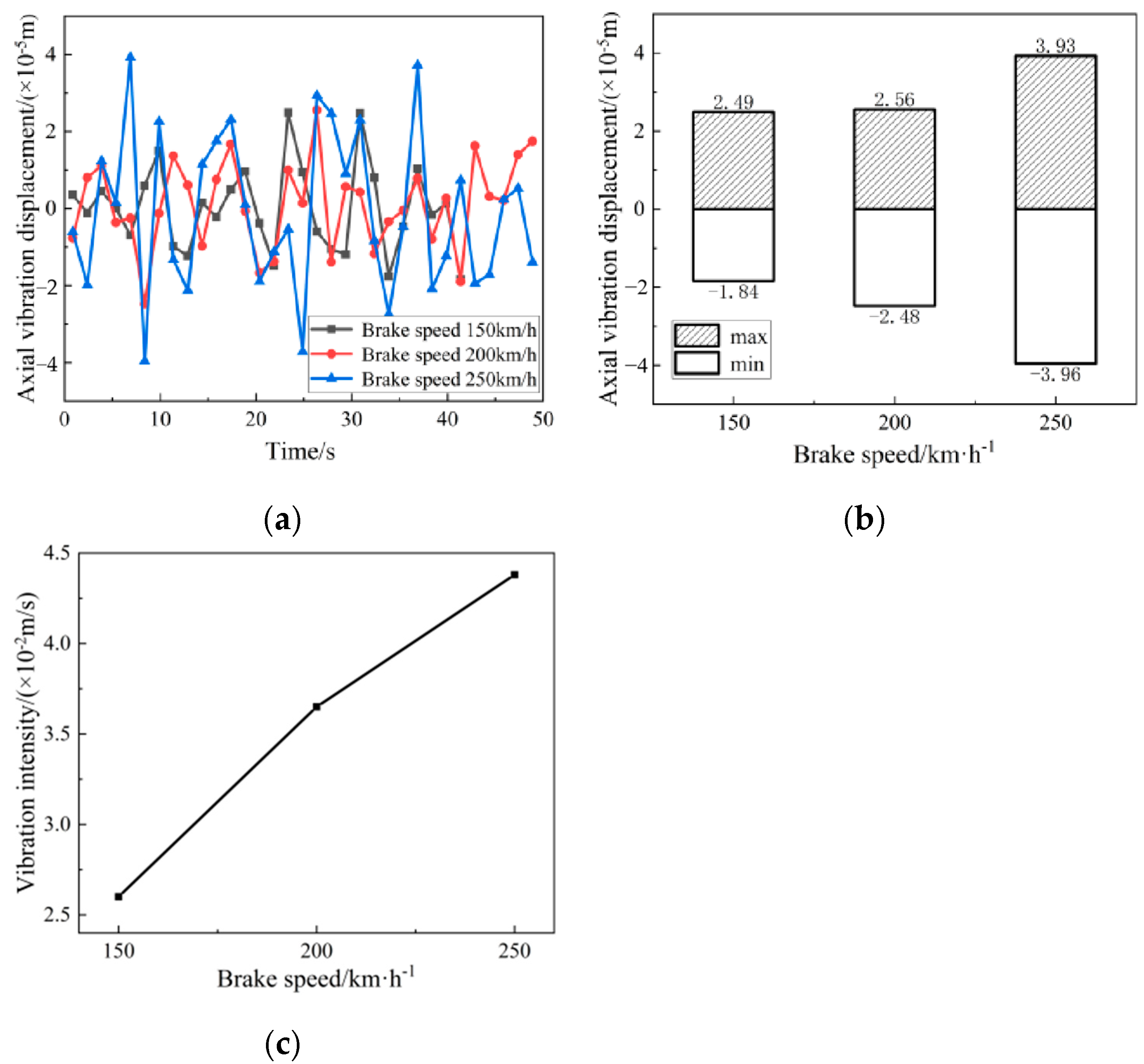1. Introduction
With the development of the rail transit industry and the continuous advancement of technology, the speed and transportation efficiency of high-speed trains have been greatly improved. As a crucial part of ensuring the safe and stable running of high-speed trains, disc brakes are commonly utilized, as shown in
Figure 1a. The brake disc and brake pads convert the kinetic energy of the high-speed train into internal energy through friction during braking. This process generates significant heat, resulting in an uneven temperature field on the brake disc and brake pads, as shown in
Figure 1b. Periodic thermal shock is then formed on the friction surface, which changes the contact state between the brake disc and brake pads and significantly affects the braking performance of disc brakes on high-speed trains.
To obtain the rules of the influence of heat on braking performance in the process of disc braking, many scholars have researched the temperature and stress distribution of the frictional heat generated by the brake during the braking process. Yevtushenko et al. [
1] proposed a new numerical simulation method for the rotational motion of the brake disc based on the finite element method and used this method to study the temperature distribution characteristics of the ventilated disc and the solid disc under emergency braking conditions. Popescu et al. [
2] took the emergency braking condition as an example to study the thermal and mechanical properties of the disc brake system and used the COMSOL structural heat transfer and solid mechanics module to obtain the brake friction heat and the thermal stress caused by heat. Mithlesh et al. [
3] analyzed the stress distribution of the brake disc while braking, and the results showed that changing the contact area between the brake disc and brake pad can effectively reduce stress. Saffari et al. [
4] provide an analytical framework based on the third-order shear deformation theory (TSDT) to conduct a comprehensive thermo-vibro-acoustic evaluation of a multi-layered asphalt system subjected to a harmonically rectangular. The study found that higher road surface temperature will lead to an increase in softness and rut depth under moving loads, and an increase in load speed will lead to a higher frequency and increased amplitude of the pressure wave. Dubale et al. [
5] performed numerical simulations for heat transfer analysis of different types of brake discs and obtained the temperature and stress distribution of different types of brake discs under emergency braking conditions. Jiregna et al. [
6] performed a thermo-solid coupling analysis of the brake disc based on the FEM method to obtain the temperature gradient distribution of the brake disc and the maximum temperature on the friction surface of the brake disc. In conclusion, it is clear that when a train brakes, the friction between the brake disc and brake pads produces a significant amount of heat, causing the brake to operate in a thermo-solid coupling environment and reducing its safety service performance, which seriously affects the working efficiency of high-speed train disc brakes.
Along with the force-heat effect in the braking process described above, braking vibration also has an impact on the braking efficiency of disc brakes on high-speed trains. Numerous scholars have investigated the vibration phenomenon that occurs during disc braking and the mechanism that causes it. Park et al. [
7] found in their study that the runout of the end face of the brake disc causes periodic changes in the friction force, which leads to the occurrence of vibrations. Lyu et al. [
8] used the transient analysis method and the complex eigenvalue method to study the vibration behavior of the disc brake for the vibration caused by friction and found that the work done by the friction force will cause the vibration of the braking system. Lazzari et al. [
9] found in their study that the interaction between the brake disc and the brake pad is the main cause of brake vibration generation. Zhang et al. [
10] studied the contact pressure distribution of the brake friction pair based on a multi-body dynamics approach and proposed that fluctuations in braking pressure can lead to the occurrence of vibration. Gao et al. [
11] explored the cause of brake vibration from the perspective of vibration energy and found that the brake disc is the main component that vibrates during the braking process. Chen et al. [
12] studied the mechanism of friction vibration by combining complex eigenvalue analysis and transient dynamic analysis methods and proposed that the repeated separation-reattachment process of friction pairs is an important mechanism leading to vibration. To study the mechanism of disc brake vibration, Zhu et al. [
13] conducted finite element analysis under different braking conditions and proposed that there is a coherent relationship between braking pressure and initial braking speed. The friction pair’s relative velocity and the contact pressure of the contact interface are not linear during the braking operation. The disc brake will vibrate while working because of the friction force and the thermal-mechanical coupling effect during the braking operation. High-speed train disc brake braking efficiency might decline due to brake vibration that causes relative displacement between the brake disc and brake pad. In some cases, the brake disc may even be unable to complete the braking process.
Scholars have carried out many studies on the vibration characteristics of disc brakes to reveal the influence of braking vibration on the braking performance of disc brakes. Ghorbel et al. [
14] proposed a two-degree-of-freedom disc brake model and obtained the influence of brake pressure and speed on vibration stability. Wang et al. [
15] used a two-degree-of-freedom dynamic model to explore the influence of braking parameters on the vibration characteristics of the brake disc and pads and found that the vibration amplitude of the brake increased with the increase of the braking load. Balaji et al. [
16] applied the complex eigenvalue analysis to the finite element model of the disc brake and found that the braking parameters and the contact stiffness of the friction pair have a significant impact on the vibration of the disc brake. Xiang et al. [
17] studied the relationship between the vibration response of the brake and the interface contact behavior and proposed that the friction coefficient and contact angle of the brake pair are important factors affecting its vibration characteristics. Cascetta et al. [
18] investigated the effect of braking parameters on the vibration characteristics and stability of the brake based on the finite element numerical simulation method. The results showed that the brake vibration was aggravated by the increase in the braking load and speed. Yan et al. [
19] studied the effect of radial stiffness on the vibration stability of a disc brake system under different friction conditions. Wang et al. [
20] established a rigid-flexible vehicle dynamics model and a finite element model of the braking system. The results showed that the wheel flat directly induced the elastic vibration of the brake disc and further affected the disc contact, resulting in a significant increase in the contact force, contact stress, friction force, and vibration acceleration between the braking interfaces. Zhang et al. [
21] established a six-degree-of-freedom nonlinear dynamics model of the disc brake system to reduce the generation of vibration and analyzed its vibration characteristics under different braking pressures and braking speeds. In summary, it can be seen that factors such as braking pressure and braking speed have a great impact on the vibration of the brake. Excessive speed and pressure will easily cause the brake to vibrate violently and reduce its braking efficiency.
In summary, the generation of vibrations has a significant impact on the braking performance of the brake system, posing safety risks during the braking process of high-speed trains. Currently, most studies on braking vibration are rely solely on dynamic methods, and the studies on thermal mechanical coupling effects in braking have not extensively explored the vibration mechanism. The majority of models disregard the role that thermal-mechanical coupling effects play in the braking process. Therefore, it is necessary to study the vibration characteristics under the action of thermo-mechanical coupling and the dynamic relationship among brake friction, heat, and vibration. This paper takes into account the simultaneity of the thermal coupling effect, as well as the impact of its value and change pattern on the temperature field and stress field distribution, to obtain more accurate vibration patterns and data obtained during the braking process. This paper takes the ventilated brake disc of high-speed trains as the research object. Based on the multi-body dynamics and thermal coupling method, combined with the working characteristics and actual working conditions of the brake, a multi-physics coupling simulation study was conducted on the braking process. Through thermal mechanical coupling simulation analysis of disc brakes, the temperature field, stress field distribution, and their changing rules during the braking process were obtained. By establishing a dynamic model under thermal-mechanical coupling effect, the changing rules of vibration characteristics of high-speed train brake discs were studied. Additionally, the vibration of the brake disc was characterized by the vibration stability index, and the changing rules of vibration stability under different working conditions were analyzed.
This paper is organized as follows:
Section 2 describes the multi-body dynamics analysis method and formulation of disc brake under thermo-solid coupling. In
Section 3, a finite element model of disc brake coupling is established, and a braking bench test is set up to verify the rationality of the model.
Section 4 discusses the results of simulation and the rules of thermo-solid coupling on the vibration characteristics.
Section 5 summarizes the key features and achievements of the work.
2. Multi-Body Dynamics Analysis Method of Disc Brake under Thermo-Solid Coupling
To more accurately study the vibration characteristics of disc brakes, a multi-flexible body dynamics model of high-speed train disc brakes taking thermo-solid coupling into account is established. This model allows for the measurement of the temperature and stress distribution of the brake disc as well as the analysis of the impact of thermo-solid coupling on the brake disc’s vibration characteristics; hence, the influence of braking parameters on the vibration response of the brake disc can be studied. Based on this research, this paper proposes a multi-body dynamics analysis method for disc brakes under the action of thermo-solid coupling.
The establishment of the disc brake multi-physical field coupling model takes the initial pressure, initial speed, and initial temperature of the high-speed train as the input conditions, and using multi-body dynamics to analyze its contact changes, the contact pressure and friction force changes between the brake disc surface and the brake pad can be obtained. In addition, the dissipation rate of friction during braking is analyzed from the perspective of energy transfer. Based on the dissipation rate of friction, the frictional heat flux is gained. Additionally, the changing rules of temperature and thermal expansion of the brake disc surface and brake pad are obtained from the perspective of structural heat transfer, heat radiation, heat convection, and heat conduction. Furthermore, the change of the contact between the brake disc surface and the brake pad after the expansion deformation is analyzed, and the characteristics of vibration during the braking process are obtained. The coupling relationship between physical fields in this method is shown in
Figure 2.
When the brake is working, the friction work causes the kinetic energy of the brake disc to be lost and converted into heat energy. The dissipation rate of friction is obtained through the calculation of multi-body dynamics. The dissipation rate of friction can be expressed as [
22]:
where
Pb is the braking power of the friction force acting on the brake disc, and
A is the contact area between the brake disc surface and the brake pad.
Loading the dissipation rate of friction on the contact surface of the brake disc and the brake pad as a frictional heat source, the generated heat flux can be expressed as [
23]:
where
q is the heat flux generated at the radius
r of the brake disc,
μ is the friction coefficient,
p is the load on the contact surface of the brake disc, and
ω is the rotation speed of the brake disc.
The brake disc surface and brake pads generate significant heat due to friction. When the heat generated by the brake is the same as the output heat, the energy equation can be expressed as:
where
Q is the heat transferred during the coupling process,
k is the heat transfer coefficient, Δ
T is the average temperature difference during the heat transfer process, and A is the area that transfers heat.
When the temperature of the brake changes, its material responds through a volume change, which can be expressed as the thermal strain of
εth, and its calculation formula can be expressed as:
where
T is the working temperature of the brake;
Tref is the volume reference temperature of the brake, that is, the temperature when no thermal expansion occurs; and
α is the secant thermal expansion coefficient of the brake material, which can be expressed as:
where
L is the length of the material after expansion, and
L0 is the reference length of the material.
The thermal expansion of the brake is restricted and cannot occur freely under the constraints of its boundary conditions, so large thermal stress is generated. For linear elastic materials, the relationship between the thermal stress
σ and its strain can be expressed as:
where
D is the elasticity matrix of the brake.
The structure of the disc brake will be deformed due to the change in temperature during the braking process. This effect is considered through thermal expansion. At the same time, the structural deformation parameters can be calculated according to the data of the brake temperature field to provide additional displacement for the multi-body dynamic motion solution. It will, in turn, affect the motion solution of multi-body dynamics.
5. Conclusions
This paper establishes a multi-body dynamics model of high-speed train disc brake thermo-solid coupling, obtains the disc surface temperature through a scaled inertia braking experiment, and compares it with the model temperature to verify the accuracy of the model. The changing rules of temperature, stress, and strain of the brake disc under the influence of vibration are obtained through the mode. Comparing the results with and without considering the thermal coupling effect, the influence of the thermo-solid coupling effect of the brake on its vibration characteristics is discussed. In addition, by extracting the vibration displacement range and root mean square value of vibration velocity at different rotating speeds and pressures, the change regulation of the vibration characteristics of the brake disc under the change of the braking speed and braking pressure is analyzed. However, due to the complexity of multi-physical field coupling analysis and the difficulty in convergence of calculations, this study does not consider the impact of wind load on vibration in the flow field during the braking process, and the impact of friction and wear on vibration during braking is not discussed. Therefore, subsequent research can be carried out from these perspectives.
Key findings include the establishment of a multi-body dynamics analysis model for the thermo-solid coupling of high-speed train disc brakes, which effectively analyzed vibration characteristics considering thermo-solid coupling effects. During the braking process, the surface temperature and stress of the brake disc were in a dynamic change process, and there was stress concentration and obvious high-temperature concentration in the friction area. When the braking initial velocity was 200 km/h and the braking pressure was 0.36 MPa, the maximum temperature and stress of the brake disc reached 226 °C and 198 MPa, respectively. The temperature and stress concentration will aggravate the local warping deformation of the friction interface. The brake disc underwent different degrees of elastic warping deformation during the braking process, and its maximum deformation reached 0.44 mm. The warping deformation caused the frictional contact surface of the brake disc to lose its flatness, resulting in uneven contact between the brake disc and the brake pad. This affected their contact state and led to the occurrence of brake vibration. Furthermore, the thermo-solid coupling effect during the braking process significantly influenced the vibration characteristics of the disc brake. When the model considered the thermo-solid coupling effect, part of the brake disc’s energy was released into the air in the form of heat energy, which reduced the severity of the vibration of the brake disc. With the increase of the initial braking speed and braking pressure, the axial vibration displacement of the brake disc increased, and the vibration velocity increased at the same time, that is, the axial vibration of the brake disc intensified.
